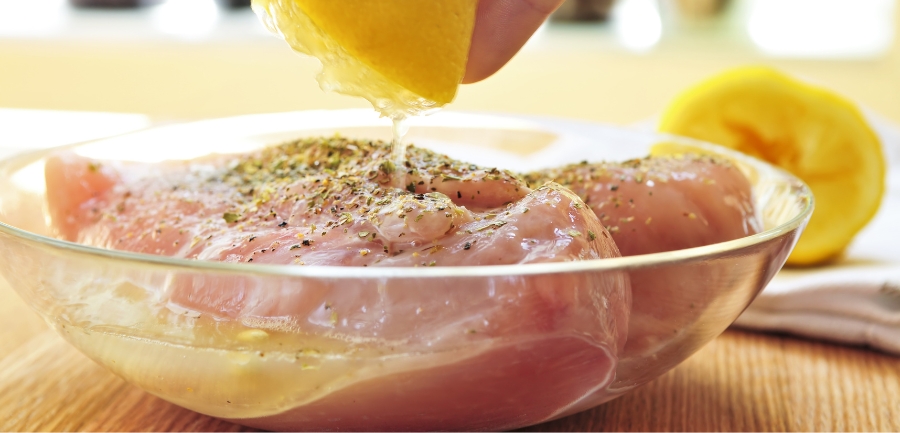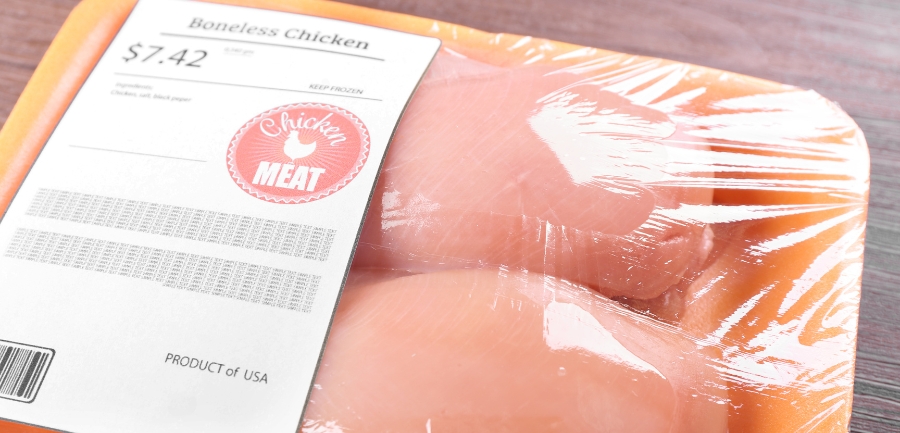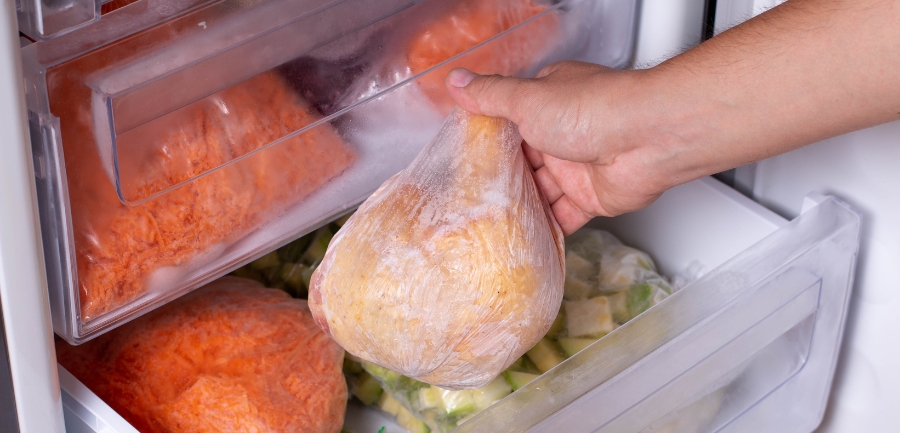Hello, fellow food enthusiasts! We’ve all been there – you buy some chicken, pop it in the fridge, and a week later you’re squinting at it, wondering if it’s still good to cook. The central question: is raw chicken in the fridge for 7 days still safe to eat? It’s not just about avoiding a culinary mishap, but more critically, safeguarding our health.
Table of Contents
Chicken, delicious and versatile as it is, demands careful handling. Whether you’re a newbie in the kitchen or someone who’s been cooking for years, the safety and storage of chicken is a topic that always warrants attention. From deciphering sell-by dates to understanding the nuances of storing chicken wings versus thighs, there’s a lot to unpack. And that’s precisely what we’ll do in this blog post!
Today, we’ll journey together through the do’s and don’ts of storing chicken, offering practical insights and addressing some of those burning questions you’ve had. Ever wondered about the specifics of dicing chicken or what to do if you’ve left frozen chicken out overnight? We’ve got you covered!
Join me as we dive deep into the world of chicken storage and safety. By the end of this read, you’ll be equipped with knowledge that will not only enhance your culinary adventures but also ensure they remain safe and scrumptious.
Raw Chicken in Fridge for 7 Days

Ah, the age-old question for those of us who’ve ambitiously bought chicken on sale: Can we still cook that chicken that’s been sitting in our fridge for a week? Let’s delve into this.
Identifying Signs of Spoiled Chicken
Before you decide to whip up that chicken curry or grill some wings, it’s vital to ensure that your chicken hasn’t gone bad. Here’s how:
- The Look, Smell, and Texture of Unsafe Chicken
Chicken that’s past its prime will often have a dull, faded color. Instead of a fresh pink or pale color, it may appear greyish. If there are any signs of mold or green patches, that’s a clear no-go.
The sense of smell can be your best ally here. Fresh chicken has a light, natural scent, while spoiled chicken will give off a strong, unpleasant odor – something that’s unmistakable “off”.
As for the texture, fresh chicken is relatively firm to the touch. If your chicken feels slimy or overly sticky, even after a good rinse, it’s time to part ways.
- Why 7 Days Might Be a Tipping Point
Chicken isn’t like wine; it doesn’t get better with age in your fridge. Generally, raw chicken (properly refrigerated) can last for about 1-2 days. But beyond that, and especially by the 7-day mark, you’re entering risky territory. The growth of harmful bacteria like Salmonella and Campylobacter can increase, raising the chances of foodborne illnesses.
Best Practices for Refrigerating Chicken
To maximize the freshness of your chicken, a few refrigerator strategies come in handy:
- Importance of Temperature Consistency Your fridge’s temperature plays a critical role in preserving your chicken’s freshness. Always ensure that the fridge maintains a temperature of 40°F (4°C) or lower. This cold environment inhibits bacterial growth, thus prolonging the chicken’s shelf life.
- Proper Placement within the Fridge Ever thought about where you place your chicken in the fridge? It matters. Store raw chicken on the lowest shelf, preferably in a shallow container or tray to catch any drips. This prevents cross-contamination and ensures other foods remain safe.
Remember, while it’s tempting to stretch the lifespan of that chicken sitting in your fridge, it’s always better to be safe than sorry. It’s about the joy of cooking, but more importantly, about enjoying our meals with peace of mind.
How Long Are Chicken Wings Good For?

Chicken wings – a favorite at gatherings, BBQs, or just a cozy evening in front of the TV. But when we’re not immediately grilling or frying them up, how long can these beloved pieces stay in our fridge without going south?
Evaluating the Freshness of Stored Wings
- Shelf Life of Refrigerated Wings: Most of us have an inkling that chicken has a limited fridge life, but wings can be a bit tricky. Typically, raw chicken wings can be safely stored in the fridge for about 1-2 days. If you’re pushing beyond this time frame, it’s crucial to check for signs of spoilage, like an off odor or a change in texture.
- Factors Affecting the Longevity of Wings: The freshness of your wings when you purchase them can greatly influence their longevity. If you’re buying wings that are nearing their sell-by date, their time in your fridge will be on the shorter side. Also, how the store handles and stores the chicken can be a determining factor. Always choose wings that are cold to the touch and stored in a chilled section at the store.
How Long Can Chicken Wings Stay in the Fridge?
- Practical Tips for Longer Storage: Planning to store those wings for a few days? Then it’s essential to refrigerate them as soon as you get home. If you have a longer commute, consider using an insulated bag with ice packs to keep the chicken cool until you reach home.
- Vacuum Sealing and Airtight Containers: If you’re someone who buys in bulk or simply wants to be proactive, vacuum sealing your chicken wings can substantially extend their fridge life by reducing exposure to air. If you don’t have a vacuum sealer, placing the wings in airtight containers or tightly sealing them with plastic wrap and foil can also help maintain freshness.
- Impact of Initial Freshness on Storage Time: Remember, the clock starts ticking the moment those wings are processed. If you purchase ultra-fresh wings from a local butcher compared to ones sitting a while in a supermarket, the former will usually last a bit longer. However, always abide by the 1-2 day general guideline for optimal safety.
In the world of chicken wings, freshness is paramount. Whether you’re prepping for game night or a family dinner, ensuring your wings are fresh not only guarantees deliciousness but also keeps everyone healthy and happy.
How Long is Chicken Good After Sell By Date?

Ever stood in your kitchen, holding a pack of chicken and puzzling over the printed dates, debating whether it’s safe to cook? The sell-by date can sometimes be a source of confusion. Let’s break it down.
Understanding Sell-By vs. Use-By Dates
- Meaning and Implications of Dates on Chicken Package
The “Sell-By” date is primarily for retailers. It tells stores how long to display the product for sale, meaning you should purchase the chicken before this date. However, it doesn’t necessarily mean the chicken has spoiled after this date. In contrast, the “Use-By” or “Best if Used By” date is a more accurate indicator for consumers. This date is a suggestion for when the chicken is at its peak quality. If stored properly, chicken can typically last another 1-2 days in your fridge after the sell-by date. But always use your senses to confirm its freshness.
- Health Risks Associated with Consuming Old Chicken
The stakes are high when dealing with outdated chicken. Consuming chicken that’s past its prime can expose you to harmful bacteria like Salmonella and Campylobacter, leading to unpleasant foodborne illnesses. Symptoms can range from abdominal cramps and diarrhea to more severe complications, especially in vulnerable individuals like children, the elderly, and those with weakened immune systems.
The bottom line? When in doubt, it’s safer to throw it out. Taking chances with chicken isn’t worth a mealtime mishap. It’s always better to prioritize health and safety over-stretching the shelf life of a product. Happy and safe cooking to all!
Uncooked Chicken Thigh: Storing and Checking for Freshness

Alright, chicken aficionados, let’s chat thighs—the unsung heroes of many a savory dish. They’re juicy, and flavorful, and can be the star of the show in curries, roasts, or grills. But just like their winged counterparts, thighs come with their own set of storage quirks.
Storage Differences Between Wings and Thighs
- Why Thighs May Have Varied Freshness Durations
You might think all parts of the chicken would age the same way in the fridge, right? Not quite. Thighs, being slightly fattier than wings, can sometimes retain their freshness a tad longer. This fat acts as a sort of barrier, helping keep harmful bacteria at bay for a bit. However, this doesn’t give you a free pass to store them indefinitely. Typically, chicken thighs, when refrigerated properly, can be good for about 2-3 days, but always be sure to check them before cooking.
- Essential Tips for Maximizing Thigh Freshness
To get the most out of your thighs (culinary-speaking, of course!):
- Keep them cold: Ensure they go from the store straight to your fridge or freezer without lingering too long at room temperature.
- Store at the Bottom: Just as with wings, place them on the lowest shelf of your fridge to prevent any potential drippage from contaminating other foods.
- Tight Seal: If you’re not using the original packaging, transfer thighs to an airtight container or resealable bag. Less air exposure means less risk of spoilage.
To sum up, while chicken thighs are a delicious and versatile ingredient, they deserve the same careful attention as any other part of the chicken. So, the next time you’re planning a sumptuous thigh-based dish, remember these storage tips to ensure a flavorful and safe culinary experience!
How to Dice Chicken

Roll up those sleeves and grab your favorite knife! Dicing chicken can be both an art and a science. Whether you’re prepping for a savory stir-fry or a hearty chicken soup, getting those perfect chicken cubes can make all the difference. Let’s dive into the nitty-gritty of dicing chicken like a pro.
Tips and Techniques for Perfect Diced Chicken
Tools and Hygiene for Safe Dicing
First and foremost, let’s gear up!
- The Right Knife: A sharp chef’s knife is your best friend here. Dull knives not only make the process harder but are also a safety hazard, as they can slip.
- Stable Cutting Board: Opt for a board with grip – you don’t want it dancing around while you’re making those cuts. Some people swear by wooden boards, while others prefer plastic. Whichever you choose, make sure it’s clean and dry.
- Clean Hands and Workspace: Wash your hands before and after handling raw chicken. Clear your workspace of unnecessary items, and always have a separate cloth or towel for raw meats.
Step-by-Step Dicing Process
Here’s a straightforward way to dice that chicken like a culinary artist:
- Trimming: Begin by trimming off any unwanted fat or skin.
- Flat Surface First: Place the chicken piece on the cutting board with its flattest side down. This gives you stability.
- Slicing: Slice the chicken into strips of your desired width. Try to keep the strips uniform for even cooking.
- Turn and Dice: Now, turn those strips so they’re horizontal to you and cut crosswise to produce cubes.
- Check Size: Take a moment to check if the sizes are consistent. Adjust as necessary. Remember, uniform pieces cook evenly.
- Clean Up: Once you’re done, immediately clean your knife, board, and any surfaces the raw chicken touched. Cross-contamination is a real thing, and we want those diced chicken pieces to be the only memory of our culinary escapade.
There you have it, fellow home chefs! With a little practice and these tips in mind, dicing chicken will soon become second nature. Happy cooking and even happier eating!
Frozen Chicken Left Out Overnight

We’ve all had those “oops” moments in the kitchen, right? Maybe you planned on preparing a grand chicken dish and left it out to thaw, only to forget it until the next morning. Now, as you stare at that no-longer-frozen chicken on your countertop, a flurry of questions rush in: Is it still safe? Can I cook it? Let’s demystify this scenario.
Determining Safety and Next Steps
- Risks of Room-Temperature Thawing
Leaving chicken to thaw at room temperature might seem like a quick solution, but it can be a dangerous game. As the chicken defrosts, it enters the “danger zone” temperature (between 40°F and 140°F), a range in which bacteria multiply rapidly. Harmful bacteria like Salmonella and Campylobacter can flourish, especially if the chicken stays in this zone for more than two hours.
What to Consider Before Cooking or Discarding
Before making a decision:
- Check the Chicken’s Core Temperature: If you have a food thermometer, check the chicken’s core. If it’s above 40°F, especially for an extended period, it’s best to discard it.
- Assess the Texture and Smell: If the chicken feels warm to the touch or emits a sour or unusual odor, it’s a clear sign that it’s not safe.
- Safety First: If you’re in doubt about the time the chicken spent thawing or its safety, it’s better to err on the side of caution. Remember, no dish is worth the risk of a foodborne illness.
- Refrigerator Thawing is Best: For future reference, always opt for refrigerator thawing. It’s slower, yes, but it ensures the chicken remains at a safe temperature throughout the thawing process.
In the end, our kitchens are spaces of creativity and nourishment. A small misstep, like leaving chicken out overnight, can happen to anyone. However, armed with knowledge and a commitment to safety, you can navigate these situations confidently and make the best decisions for you and your loved ones. Bon appétit (safely)!
To Wrap It Up!
Navigating the intricacies of chicken storage and preparation might seem daunting, but with the right knowledge, it becomes a walk in the park. From understanding sell-by dates to mastering the art of dicing and ensuring safety with thawing, every step ensures we relish our meals without a worry. Remember, the kitchen isn’t just a place to cook; it’s where we fuse safety with flavor. So, here’s to many more safe, delicious chicken dishes, and to always putting health and taste on the same plate. Happy cooking, everyone!
FAQs
Is raw chicken OK in the fridge for 7 days?
No, raw chicken should not be stored in the fridge for 7 days. Typically, it’s safe for only 1-2 days before potential spoilage.
Is raw chicken safe after 5 days?
Raw chicken stored for 5 days risks bacterial growth. Always check for signs of spoilage and, when in doubt, discard it.
How do I know if chicken is bad?
Spoiled chicken may have an off-odor, slimy texture, and a greyish color. Trust your senses; if it seems off, it probably is.
What happens if you accidentally eat spoiled chicken?
Consuming spoiled chicken can lead to food poisoning, resulting in symptoms like nausea, diarrhea, vomiting, and abdominal pain.
What happens if you cook chicken that’s gone bad?
Cooking might kill bacteria, but toxins possibly produced by these bacteria can remain, posing a risk of food poisoning. Always prioritize freshness.

